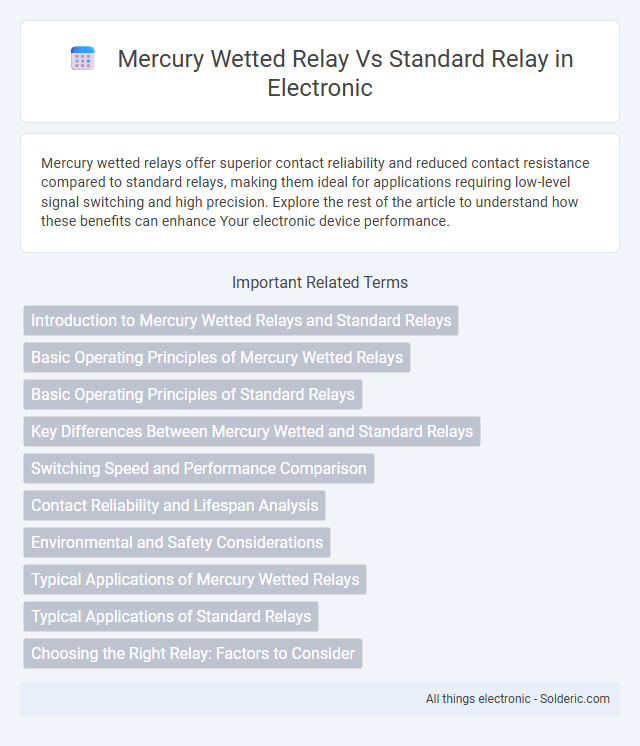Mercury wetted relays offer superior contact reliability and reduced contact resistance compared to standard relays, making them ideal for applications requiring low-level signal switching and high precision. Explore the rest of the article to understand how these benefits can enhance Your electronic device performance.
Comparison Table
| Feature | Mercury Wetted Relay | Standard Relay |
|---|---|---|
| Contact Material | Mercury-wetted contacts | Metal or alloy contacts (silver, gold, etc.) |
| Contact Resistance | Very low and stable (<10 mO) | Higher and may vary over time |
| Switching Speed | Fast switching due to liquid contact | Moderate speed |
| Contact Life | Long life, minimal contact wear | Shorter life, subject to contact erosion |
| Arc Suppression | Excellent arc suppression | Arc tends to cause more erosion |
| Environmental Impact | Contains toxic mercury, hazardous disposal | Generally safer, easier disposal |
| Applications | Precision switching, low-level signals | General purpose switching |
| Cost | Higher cost due to mercury and design | Lower cost, widely available |
Introduction to Mercury Wetted Relays and Standard Relays
Mercury wetted relays use a thin layer of mercury to create a highly reliable and low-resistance contact, offering superior performance for high-speed switching and minimizing contact bounce compared to standard mechanical relays. Standard relays typically rely on metal-to-metal contacts that can degrade over time due to arcing and wear, resulting in reduced lifespan and less consistent electrical performance. You can choose mercury wetted relays for applications requiring precise, long-lasting switching with minimal signal interference, while standard relays suit general-purpose switching tasks.
Basic Operating Principles of Mercury Wetted Relays
Mercury wetted relays operate using a small pool of liquid mercury to make and break electrical contacts, providing exceptionally low contact resistance and minimal contact erosion. The liquid mercury forms a stable, self-healing contact surface, resulting in high reliability and consistent performance especially in signal switching and low current applications. Standard relays utilize solid mechanical contacts that open and close through physical separation, often leading to contact wear, arcing, and higher resistance over time.
Basic Operating Principles of Standard Relays
Standard relays operate by using an electromagnetic coil that generates a magnetic field when energized, which moves an armature to open or close electrical contacts. This switching mechanism allows the relay to control a high-power circuit with a low-power signal. The contacts in standard relays are usually made of materials such as silver alloys to ensure good conductivity and durability during mechanical switching.
Key Differences Between Mercury Wetted and Standard Relays
Mercury wetted relays utilize a thin layer of liquid mercury to ensure low contact resistance and minimal contact bounce, offering superior reliability and consistent electrical performance compared to standard relays that rely on mechanical metal contacts. These relays are particularly advantageous in applications demanding fast switching and high precision, as the mercury contacts provide faster response times and extended contact life by reducing wear and oxidation. Your choice between mercury wetted and standard relays should consider factors like environmental impact, as mercury relays require careful handling due to toxic components, while standard relays offer broader compatibility and ease of replacement.
Switching Speed and Performance Comparison
Mercury wetted relays offer significantly faster switching speeds, typically in the range of 0.5 to 5 milliseconds, compared to standard electromechanical relays that switch in 5 to 15 milliseconds. The mercury contact ensures low contact resistance and consistent performance, reducing bounce and arcing that can degrade standard relay contacts. Your application will benefit from the enhanced reliability and precision of mercury wetted relays in high-speed switching environments.
Contact Reliability and Lifespan Analysis
Mercury wetted relays offer superior contact reliability due to their liquid mercury contacts, which reduce contact resistance and prevent arcing, resulting in more consistent performance compared to standard relay contacts. The lifespan of mercury wetted relays is significantly longer, often exceeding millions of operations, because the mercury's self-healing surface minimizes wear and contamination. Your choice of relay impacts system durability, especially in applications requiring frequent switching and high precision.
Environmental and Safety Considerations
Mercury wetted relays contain liquid mercury, posing environmental hazards due to mercury's toxicity and potential soil and water contamination if leaked or improperly disposed. Standard relays eliminate these risks by using solid contacts without hazardous materials, making them safer for both operators and the environment. Regulatory restrictions on mercury use emphasize the need for disposal protocols and encourage the shift toward environmentally friendly relay technologies.
Typical Applications of Mercury Wetted Relays
Mercury wetted relays are commonly used in precision measurement, medical equipment, and telecommunications due to their low contact resistance and reliable switching performance. Their high durability and resistance to contact contamination make them ideal for applications requiring stable, long-term operation in sensitive electronic circuits. Compared to standard relays, mercury wetted relays excel in minimizing contact bounce and electrical noise, enhancing signal integrity in critical control systems.
Typical Applications of Standard Relays
Standard relays are commonly used in automotive systems, household appliances, and industrial control circuits due to their reliability and versatility in switching electrical loads. Your control panels and HVAC systems often employ standard relays for motor control, lighting, and signal switching tasks. These relays excel in applications requiring moderate switching speed and durability without the need for mercury's specific benefits like tilt sensitivity or hermetic sealing.
Choosing the Right Relay: Factors to Consider
Choosing the right relay requires evaluating key factors such as contact reliability, switching speed, and environmental durability. Mercury wetted relays offer low contact resistance and excellent repeatability, making them ideal for precision applications requiring minimal signal distortion. Standard relays provide versatility and cost-effectiveness for general-purpose use but may have higher contact wear and slower switching times compared to mercury wetted alternatives.
Mercury wetted relay vs standard relay Infographic

 solderic.com
solderic.com